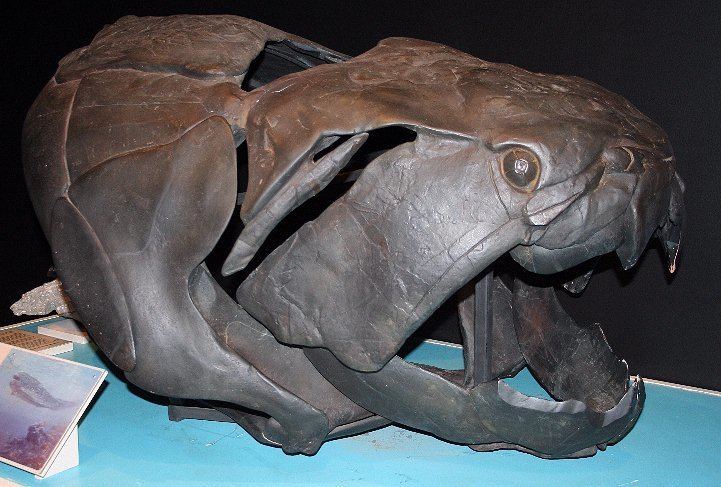Class †Placodermi Superfamily †Dunkleosteoidea | Phylum Chordata | |
 | ||
Family †DunkleosteidaeStensiö, 1963 | ||
Dunkleosteidae is an extinct family of arthrodire placoderms. The gigantic apex predator Dunkleosteus terrelli is the best known member of this group. While they were previously thought to be close relatives of the genus Dinichthys (when they were not synonymized as each other) and grouped together in the family Dinichthyidae, more recent studies have shown that the two taxa represent two very distinct clades within Arthrodira. The reappraisal of Kiangyousteus lead to a restructuring of the family, with the inclusions of the benthic, aberrant Heterosteus (and the other members of Heterosteidae) as the sister taxon of Dunkleosteus, and the Late Emsian Xiangshuiosteus as the sister taxon of Eastmanosteus calliaspis (with the direct implication that E. calliaspis does not belong in Eastmaneosteus), and the removal of Westralichthys from the family (now thought to be the most basal member of the superfamily Dunkleosteoidea, and sister taxon of Panxiosteidae and Dunkleosteidae)
Contents
Dunkleosteus
The type genus, Dunkleosteus, is known from Late Frasnian and Famennian-aged marine strata from Europe, Morocco, and North America. The best known species, D. terrelli, is famous as the "world's first vertebrate apex predator," and is estimated to be up to 6 m (20 ft) in length: other species, however, such as D. raveri, are estimated to be 1 m (3.3 ft) in length.
Eastmanosteus
Eastmanosteous is a diverse genus of medium to somewhat large predatory arthrodires very similar in anatomy to the species of Dunkleosteus. Eastmanosteus differs from Dunkleosteus in having a unique tubercle-ornamentation on the dermal surfaces of the plates, a distinctively shaped nuchal plate, and sutures that are more zigzagging. The best studied species, E. calliaspis may not be of this genus due to its recently appreciated relationship to the Emsian-aged genus Xiangshuiosteus.
Golshanichthys
Fossils of Golshanichthys are found in Frasnian-aged marine strata near Kerman, Iran.
Herasmius
This aberrant, benthic genus is known from freshwater deposits of the early Eifelian-aged Verdalen member of the Stjørdalen formation in the Wood Bay series, Spitzbergen, Norway. In addition to being smaller than Heterosteus, Herasmius differs by having a comparatively broader, shorter skull.
Heterosteus
This aberrant, benthic genus, together with the other two genera from Heterosteidae, make up the sister taxon of Dunkleosteus. Heterosteus is sometimes described as a "giant arthrodire," as the type species, H. asmussi, has an estimated body length of up to 6 meters. The genus differs from Herasmius by having the orbits on slightly longer eye stalk-like projections. The various species are found in Givetian-aged deposits in Europe and Greenland. With the exception of the German H. rhenanus, all species are known from freshwater deposits: H. rhenanus is based on fragments found in a marine deposit.
Kiangyousteus
This Middle Devonian genus represents the first arthrodire described from China. Fossils are known from the Late Givetian to Early Frasnian-aged Guanwu Formation in Sichuan.
Xiangshuiosteus
Xiangshuiosteus was originally described as an arthrodire incertae sedis with anatomical features suggestive of both buchanosteids and coccosteids. With the reappraisal of Kiangyousteus, it is now thought to be a dunkleosteid most closely related to Eastmanosteus calliaspis.
Yinostius
This aberrant, benthic genus is known from Emsian-aged specimens from the Wuding region of Yunnan, China. In overall anatomy, it is extremely similar to the European genera Heterosteus and Herasmius, though it differs from them in its slightly smaller size, the shape of its nuchal plate, and in various body proportions.
